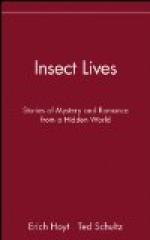Passing over some doubtful remains of Silurian age, we find in rocks usually regarded as Devonian[13] the most ancient fossils that can be certainly referred to the insects, while from beds of the succeeding Carboniferous period, a number of insect remains have been disinterred. These Palaeozoic insects were frequently of large size, and they show distinct affinities with our recent may-flies, dragon-flies, stone-flies, and cockroaches. In the Permian period, the latest of the divisions of the Palaeozoic, lived Eugereon, an insect with hemipteroid jaws and orthopteroid wings. All these insects must have been exopterygote in their life-history, if we may trust the indications of affinity furnished by their structure. In the Mesozoic period, however, insects with complete transformations must have been fairly abundant. Rocks of Triassic age have yielded beetles and lacewing-flies, while from among Jurassic fossils specimens have been described as representing most of our existing orders, including Lepidoptera, Hymenoptera and Diptera. In Cainozoic rocks fossil insects of nearly six thousand species have been found, which are easily referable to existing families and often to existing genera. We may conclude then, imperfect though our knowledge of extinct insects is, that some of the most complex of insect life-stories were being worked out before the dawn of the Cainozoic era. Some instructive hints as to differences in the rate of change among different insect groups may be drawn from the study of parasites. For example, V.L. Kellogg (1913) points out that an identical species of the Mallophaga (Bird-lice) infests an Australian Cassowary and two of the South American Rheas; while two species of the same genus (Lipeurus) are common to the African Ostrich and a third kind of South American Rhea. These parasites must have been inherited unchanged by the various members of these three families of flightless birds from their common ancestors, that is from early Cainozoic times at latest. On the other hand, the various kinds of such highly specialised parasites as the warble-flies of the oxen and deer, must have become differentiated during those later stages of the Cainozoic period which witnessed the evolution of their respective mammalian hosts.
[13] The ‘Little River’ beds of St John, New Brunswick, Canada, by some modern geologists however considered as Carboniferous.
The foregoing brief outline of our knowledge of the geological succession of insects shows that the exopterygote preceded, in time, the endopterygote type of life-history. We have already seen that those insects undergoing little change in the life-cycle, and with visible, external wing-rudiments, are on the whole less specialised in structure than those which pass through a complete transformation. These two considerations, taken together, suggest strongly that in the evolution of the insect class, the simpler life-history preceded the more complex. Such a conclusion seems reasonable




